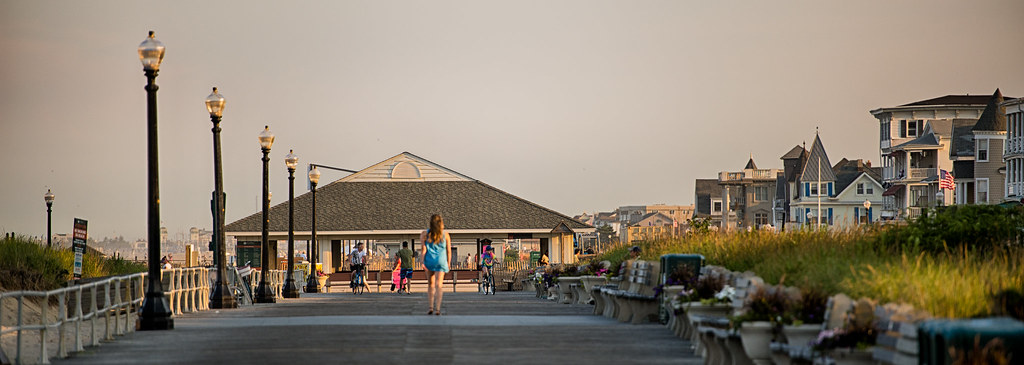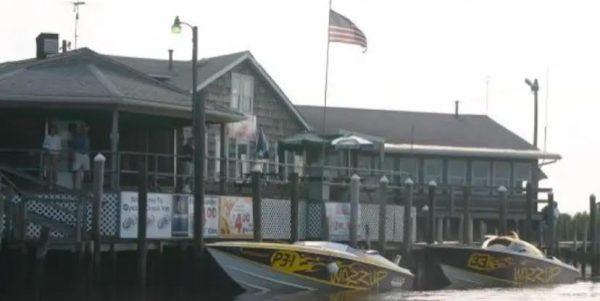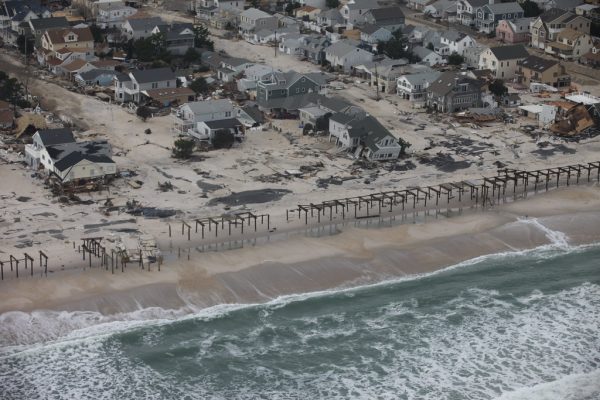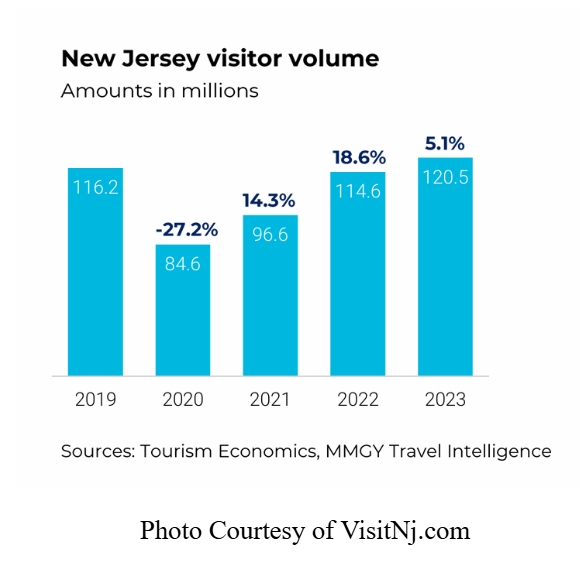
Nathan Siemers
Photo Courtesy of Nathan Siemers through Creative Commons.
With a bar right on the water and a plethora of fresh seafood, tourists from far and wide have gathered at New Jersey’s own Oyster Creek Inn, located in Leed’s Point, New Jersey. The restaurant has become a hotspot for tourists and locals alike to dine on some cult classic cuisine.
Locals may love the family run restaurant, but this inn thrives off of tourism and visitors from around the country.
The Oyster Creek Inn isn’t the only business in the South Jersey area that blossoms with tourism. As winter turns to spring and spring turns to summer, more and more people yearn for a weekend getaway and a nice trip to a beachy destination. The Jersey Shore is a hotspot for tourists craving those vacation desires.
Jersey Shore businesses of all kinds thrive off of the tourism industry and the thousands of people traveling to the beaches each summer, but as floods worsen and become more frequent, it is hard to see the future of beach businesses.

“I think it might become essentially less practical for businesses and homeowners to rebuild in between flooding events when they know that the flooding frequency is just going to continue to increase,” said Dr. Lauren Kipp, oceanographer and environmental science professor at Rowan University. “You know, less practical or more expensive.”
While beachlovers may not see drastic changes in their oceans, over time beach towns will face extreme changes due to the increasing sea levels. While New Jerseyans may not be able to physically see any oceanic changes, the changes are on a “relatively slow time frame, measured in fractions of an inch per year,” according to the NRDC.
Yet the state’s sea levels will continue to rise in a long and slow process, and the effects of sea level rise on the Garden State will continue to occur. As sea levels rise and strong storms occur more frequently, coastal communities may experience flooding due to storm surges and sunny day flooding.
“An impact of sea level rise, of course, is flooding… if we had another hurricane, Sandy for example, like that flood would reach farther inland because of sea level rise, like, because the base water table is higher,” said Kipp.
Flooding due to storm surges isn’t the only type of flooding that occurs at the Jersey Shore.
“We can have what’s called ‘sunny day flooding,’ which is where, like at the highest high tide level, that can sometimes be enough to cause floods, even though there’s not a storm… It could happen any day,” Kipp said. “It’s just related to tidal cycles, and when we’re at the peak tide cycle, where we would normally have the highest water level, again, sea level rise is just raising the baseline water level, so that now that high, high tide level is high enough to cause a flood.”

Due to the rising sea levels relating to climate change, flooding events will likely continue to occur as the tides get higher. South Jersey has already seen an increase in flooding events. The amount of high tide flooding increased from an average of one per year in the 1950s, to an average of 8 flooding events per year as of the 2000s, according to Rutgers-New Brunswick New Jersey Climate Change Resource Center.
The last time the inside of The Oyster Creek Inn flooded was in 2012, after SuperStorm Sandy. Despite the flood in 2012, the inn hasn’t seen any detrimental flooding since the 60s, said co-owner of The Oyster Creek Inn, Jason Kuppel. While the inside of the restaurant has been flood free for the last 10 years, the parking lot of the establishment has seen flooding issues due to high tides.
“The parking lot, like, the corners of the parking lot, every once in a while will flood, like in the nor’easter or, you know, a couple days of northeastern wind and full moon,” said Kuppel.
While the business may experience minimal flooding, it isn’t due to storm surges but instead, to high tide.
“Most people think that because of rain and stuff like that… that has nothing to do with us, because all the water from rain storms runs off into the creek and the bay and stuff like that,” said Kuppel.
The Oyster Creek Inn isn’t the only shore town business affected by flooding.
Vagabond Kitchen and Taphouse is a successful bar and grille located in the heart of Atlantic City. Located on the waterfront, the restaurant has provided locals and tourists alike with a plethora of juicy burgers and refreshing drinks, but that’s not the only thing guests can expect at the taphouse.
Similarly to The Oyster Creek Inn and hundreds of other restaurants and businesses down the shore, the Vagabond Kitchen and Taphouse sometimes faces flooding, ultimately impacting business.
 “Where we’re located, you know, right across from the bay, it is an issue for business,” said the restaurant’s owner, Thomas Harris. “It is an issue for customers. Sometimes if there is a really bad storm, we’re almost completely surrounded by water, and if you’re in the property, you’re almost stuck in the property. Once the tide comes all the way out, it does go down quickly, but the whole process is a couple hours, and we do experience it.”
“Where we’re located, you know, right across from the bay, it is an issue for business,” said the restaurant’s owner, Thomas Harris. “It is an issue for customers. Sometimes if there is a really bad storm, we’re almost completely surrounded by water, and if you’re in the property, you’re almost stuck in the property. Once the tide comes all the way out, it does go down quickly, but the whole process is a couple hours, and we do experience it.”
Kipp noted: “Water level is going to impact the infrastructure and businesses and homeowners, because you’re going to have more frequent flooding events, and potentially stronger flooding events, and therefore you have less time in between those events to rebuild or make repairs.”
While flooding may be an issue plaguing hundreds of Jersey Shore businesses, it is hard to tell what the future holds for these businesses as flooding increases but tourism increases. Despite businesses facing more flooding events and businesses having to scramble to solve these problems, more and more people continue to visit the Jersey Shore, growing the economy and benefiting business.
In 2023, there was a 3.2% growth in total visitor volume compared to total visitor volume in 2022, in Atlantic County. With that rise in visitors and tourists, the amount of total tourism spending also increased 4.1%, giving Atlantic County a total of $80 billion in total visitor spending.
From airfare to hospitality, visitors are likely to spend their money on a variety of businesses while visiting New Jersey. In 2023, food and beverage spending alone increased from $1.2 billion to $13.5 billion. In that same year, an estimated $50 billion was spent by visitors, which was an 8% increase from 2022.
It is no secret that tourism affects businesses and the economics of an area. While visiting an area, tourists must splurge on accommodation, travel, hospitality, entertainment and food. The money tourists spend is directly related to the economics of the area they are visiting. This rings true for counties along the Jersey Shore.
 As sea levels continue to rise, storms will continue to get stronger and tides will get higher, causing more and more flooding events. As more flooding events unfold, tourism may decrease, but it is hard to predict. If tourism rates start to decrease, beachtown businesses will lose a large portion of their revenue.
As sea levels continue to rise, storms will continue to get stronger and tides will get higher, causing more and more flooding events. As more flooding events unfold, tourism may decrease, but it is hard to predict. If tourism rates start to decrease, beachtown businesses will lose a large portion of their revenue.
The Jersey shore is a favorite travel destination for residents across the tri-state area. With its upbeat environment and flashy beach shops, the Jersey Shore has become a fan favorite for a quick getaway, but the future of these beloved businesses is unclear due to the rising sea levels and the risk of flooding.
“It’s going to happen in the future as sea levels continue to rise, and it’ll impact different areas differently based on their elevations and the topography and stuff, but that’s something that will definitely start to feel the impact of more as sea levels continue to rise,” said Kipp.